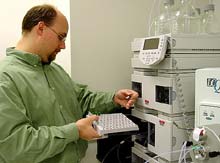Life Sciences and Chemistry
Articles and reports from the Life Sciences and chemistry area deal with applied and basic research into modern biology, chemistry and human medicine.
Valuable information can be found on a range of life sciences fields including bacteriology, biochemistry, bionics, bioinformatics, biophysics, biotechnology, genetics, geobotany, human biology, marine biology, microbiology, molecular biology, cellular biology, zoology, bioinorganic chemistry, microchemistry and environmental chemistry.

PNNL expands blood serum protein library
In a significant scientific advance, researchers at the Department of Energy’s Pacific Northwest National Laboratory have identified or confirmed 490 proteins in human blood serum — nearly doubling the number of known serum proteins, according to a paper accepted for publication in the December issue of Molecular and Cellular Proteomics.
“We have performed the most extensive identification of proteins in serum to date,” said Joel Pounds, corresponding author and a PNNL staff scientist. “We s

’Binary’ enzyme created by TSRI scientists demonstrates Darwinian evolution at its simplest
Two scientists at The Scripps Research Institute (TSRI), Research Associate John S. Reader, D.Phil, and Professor Gerald F. Joyce, M.D., Ph.D., both of the institute’s Department of Molecular Biology, have succeeded in creating an enzyme based on a “binary” genetic code–one containing only two different subunits.
This research, described in the latest issue of the journal Nature, demonstrates that Darwinian evolution can occur in a genetic system with only two bases, and it also suppo

Blasting Antibodies with Lasers Provides Direct Way of Measuring Their Flexibilities
A group of scientists at The Scripps Research Institute (TSRI) and San Diego Supercomputer Center at the University of California at San Diego (UCSD) have used a powerful laser in combination with innovative quantum mechanical computations to measure the flexibility of mouse antibodies.
The new technique, described in an upcoming issue of the journal Proceedings of the National Academy of Sciences, is significant because protein flexibility is believed to play an important role in antibody-a

Microorganism isolated in space
How far up into the sky does the biosphere extend? Do microorganisms exist at heights of 40 km and in what quantity? To answer these questions several research institutes in India collaborated on a path-breaking project to send balloon-borne sterile “cryosamplers” into the stratosphere. The programme was led by cosmologist Professor Jayant Narlikar, Director of the Inter University Centre for Astronomy and Astrophysics in Pune, with scientists at the Indian Space Research Organisation and the Tata In

Gene responsible for anemia (type CDA-1) discovered
A rare type of the disease found mainly in Bedouins may provide insight into anemia
A combined effort between scientists at Schneider Children’s Medical Center of Israel, Tel Aviv University, and the Weizmann Institute of Science has led to the discovery of a gene responsible for a type of anemia primarily found in a number of Bedouin families, called congenital dyserythropoietic anemia-1 (CDA-1). The findings, published in the December issue of The American Journal for Human Gen

Got milk? Scientists discover key lactation gene
Dr. Mario Capecchi and colleagues at the University of Utah and the Department of Veterans Affairs Medical Center (Salt Lake City, UT) have discovered that a gene called xanthine oxidoreductase, or XOR for short, is required for lactation in female mice. This previously unidentified role for XOR in lactation reveals a possible genetic basis for the lactation difficulties experienced by nearly 5% of women.
XOR was originally identified as encoding an enzyme involved in purine catabolism (the